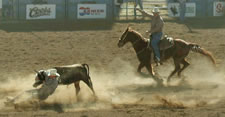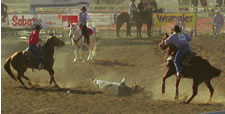
Dimdima
Online Children's Magazine from India

Dimdima
Online Children's Magazine from India

With March upon us, Arizonians are all set to enjoy what is left of the cooler temperatures before the hot summer sets in. My pals are gearing up for an adventure of their own. They are travelling deep into the desert to witness an event called La Fiesta de los Vaqueros. The fiesta, popularly known as a “Rodeo,” has all the ingredients of a spicy old-fashioned Western movie -- cowboys, cowgirls, bull rides, steer-back races, colourful costumes and rides on historic wagons. Why don’t we giddyup, say “Hee haw,” and join my pals in their quest for the “Old West”?
Rodeo (pronounced ro-day-oh) is a derivative of rodear, a Spanish word which means “to encompass, to surround or to wrap up.” The derivative, rodeo, was used to describe the rounding up of cattle. The history of the rodeo dates back to the late 1700s. In those days, Spain ruled over most of what is now called the “American West.” Cattle rearing became an important occupation among the early settlers of this region. The size and importance of a ranch grew in proportion to the amount of cattle heads the ranchero owned. There was a constant demand for skilled horsemen who could manage the herds. Since the Spanish word for cow is vaca, the men working with the cattle came to be known as vaqueros.
During the early days, vaqueros were mostly men of Mexican origin. Eventually, after America gained control over the land, American “cowboys” became popular. The cowboys worked hard to keep their herds in check. They used tools like the lariat and the lasso to catch the cattle. On rare occasions they would have to round up the cattle from the open ranges and drive them through miles of open land to market centers. On such days, after the work was done, the men would challenge their counterparts from other ranches to see who the best vaquero was. This is how the concept of the rodeo was born.
When railroads became popular in the American Southwest, cattle could easily be transported to marketplaces via coaches. The need for skilled vaqueros and cowboys decreased. These skilled men had to now look for other avenues to earn money. Formal rodeo events proved to be a blessing in disguise. Legend has it that the first formal rodeo was held in Cheyenne, Wyoming, in the year 1872. Within the next 20 years, rodeos became a regular feature during 4th of July celebrations and cattlemen parades. These annual roundups attracted contestants and spectators from all over Western and Southwestern America.
Today, rodeo is a million dollar industry, where contestants compete in 
several standardized events like bull riding, bare-back riding, calf roping, saddle bronc riding, steer wrestling, and team roping. Barrel racing is an event meant for women. The events at the rodeo can prove dangerous for the most skilled horsemen. Most rodeos, therefore, have specially trained men to look out for the safety of the cowboys and cowgirls. These versatile people are known as rodeo clowns. Clowns use bright costumes and loud hats to distract dangerous bulls from attacking injured riders. They also help entertain the spectators with silly jokes and antics in between events.
Tourists and spectators who visit rodeo events can get a feel of what life must have been like for a cowboy during the cattle ranching days. Larger purse awards, impartial judges, standardized events and consistent rules have made it a nationally recognized competitive sport. Millions of viewers tune in to watch the finals of much publicized rodeos like the National Finals Rodeo held in Las Vegas. Indeed this sport has come a long way from its humble beginnings.
Notes:
Fiesta – Spanish for “party”
Bare-back riding – An event where the rider holds on to a special rigging that looks like the handle of a suitcase. This is mounted just behind the horse's shoulders. The horse bucks wildly and the rider has to keep himself from falling off.
Barrel Racing – Women riders race their horses around barrels set in a cloverleaf pattern during this event.
Bull Riding – In this dangerous event a flat rope is placed around the bull, right behind its shoulders. The rider has to wrap the rope around his hand and ride the bull around the arena.
Calf Roping – In this timed event, the cowboy must rope a calf from atop horseback. He then dismounts and ties three legs of the calf with a string. He loosens this string after getting on top of the horse again. If the calf escapes within five seconds, the cowboy gets disqualified.
Saddle Bronc Riding – An event where the rider holds on to a single halter rope and sits on a special light saddle while the horse bucks.
Steer Wrestling – This is an event where a cowboy leans from a running horse and catches the horns of a steer. He then slides from his horse onto the ground, stops the steer and wrestles him to the ground.
Lariat – A long-noosed rope used to catch animals
Lasso – Word used in place of lariat
Ranchero – Owner of the ranch
Vaquero – A term used especially in southwestern and central Texas and `buckaroo' is used especially in California, to describe a person who tends cattle and performs other duties on horseback.
4th of July – American Independence Day
Dimdima is the Sanskrit word for ‘drumbeat’. In olden days, victory in battle was heralded by the beat of drums or any important news to be conveyed to the people used to be accompanied with drumbeats.
Bharatiya Vidya Bhavan
K. M Munshi Marg,
Chowpatty, Mumbai - 400 007
email : editor@dimdima.com
Bharatiya Vidya Bhavan
505, Sane Guruji Marg,
Tardeo, Mumbai - 400 034
email : promo@dimdima.com
Dimdima.com, the Children's Website of Bharatiya Vidya Bhavan launched in 2000 and came out with a Printed version of Dimdima Magazine in 2004. At present the Printed Version have more than 35,000 subscribers from India and Abroad.